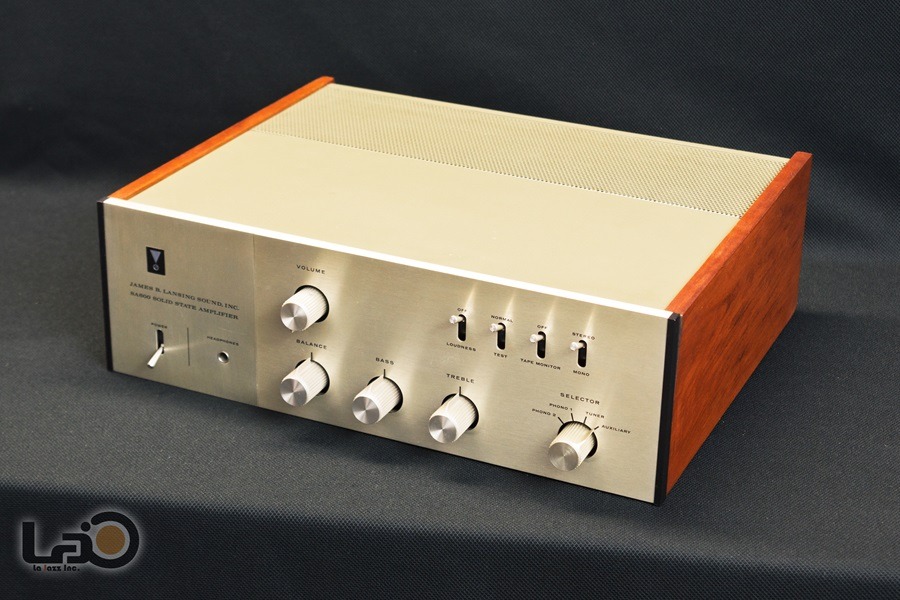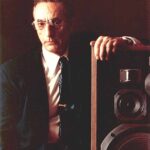Your basket is currently empty!

Amplifier History: The JBL SA-600
The beautifully styled JBL SA-600 amplifier was launched by the James B. Lansing company in 1966, and Bart Locanthi (the designer) wrote the technical article (link further down) in January 1967. This is one of the earliest – if not the earliest – example of a commercial amplifier that addressed the potential for TIM/SID and that of Large Signal Non-linearity (LSN).
In the mid 1960’s, most engineers were still working with tubes which had low loop gains and were not equipped to deal with the wider bandwidths, higher loop gains and attendant phase shifts that multi-stage solid state amplifiers offered. However, the SA-600 designer, Bart Locanthi, had cut his teeth on military guidance systems in the 1950’s – the heyday of the analog computer – and would have been, as I have remarked elsewhere on this site, highly cognisant of things like slew rate, slewing distortion, loop gain, phase margin, overshoot and so forth. Unusually for the time, the front end diff pair (Q7 & Q8) is degenerated and loop compensation provided by an 82 Ohm and 150 pF resistor across their collectors along with a 220 Ohm and 75pF network from the VAS output to ground. It operates in inverting mode, which has been tried on numerous commercial amplifiers over the years (the modern take on this is that non-inverting mode offers advantages with respect to noise performance). This design delivered 30 Watts RMS per channel, which was more than enough for the efficient loudspeakers of the day, and quite in line with the general power levels on offer from tube based gear.
Locanthi’s EF3 output stage, nicknamed the ‘T’, has remained the go to circuit for high performance solid state amplifiers – it features wide bandwidths, very high current gain, and can easily be scaled up by adding output transistors in parallel. Because of the high gains involved, care is needed in layout along with good local decoupling. Although we do not have the rest of the power supply details, it seems this was well taken care of along with the base stoppers preceding Q3 and Q4.

Nowadays, we would do things a little differently insofar as compensation goes (for example, the VAS would not be loaded to ground), and the VAS would certainly be loaded with a current source in the manner described by Douglas Self’s ‘blameless’ amplifier. Nevertheless, this design is a classic and was years ahead of its time in a number of very important aspects. Otala’s paper on TIM was still a few years away and he would regrettably draw the wrong conclusions from his findings i.e. that TIM is the result of feedback. We now know this is emphatically not the case – its all about how it is applied.
It should be remembered that solid state devices were still in their infancy, and very expensive compared to todays prices – this required some creative engineering to minimize costs and still end up with reasonable performance which this design certainly does.
However, the other fascinating thing about this amplifier is that it has held up its value remarkably – a bit like a Rolex watch. If you root around on eBay or any of the pre-owned hi-fi websites, you are unlikely to pick up a cosmetically good working unit for less than about $2000 (!) and I’ve seen immaculate exemplars for sale at over $4000 (eBay Japan). So, highly regarded in its day for its liquid tube like sound, and still sought after as a collector’s piece – which just goes to show that a well-engineered product – be it solid state or tube – can hold its value for decades and still deliver an outstanding listening experience when partnered with sympathetic ancillary gear.
You can read Locanthi’s original description of his design below :-
Here is a short review of the amplifier done in 1966 by Julian Hirsch
JBL – SA-600 Stereo Amplifier (J.D.Hirsch) (1966)
A vintage JBL SA600, recently restored for a member of Audio Science Review, underwent technical assessment by the ‘Chief Fun Officer’, Amirm. While the restoration was extensive, my analysis suggests the amplifier still exhibits residual faults. Specifically, the measured level of hum and noise, even by 1966/67 standards, would have been considered unacceptable for a product of this calibre. Modern, well-engineered amplifiers will surpass the JBL SA600 in terms of absolute hum, noise floor, and distortion levels and this simply reflects the maturation of audio design, where knowledge has disseminated widely since the SA600’s era.
Despite these observations, reviewer Amirm acknowledged the amplifier’s performance considering its 60-year vintage. Notably, Julian Hirsch’s original review cited measured hum and noise figures exceeding -100 dB, a remarkable achievement. In my view, this discrepancy suggests the restored unit tested by ASR may still harbour unresolved issues. At the time, the SA600 competed primarily with tube amplifiers, which exhibited higher noise, hum, and distortion while delivering significantly less power than the SA600’s conservatively rated 30 to 40 watts, as noted by Hirsch.
Interestingly, the placement of input and power connectors on the amplifier’s bottom chassis reflects the prevailing audio system design of the time. In an era where systems were often integrated into wooden consoles, this configuration facilitated efficient cable management.
Comments
3 responses to “Amplifier History: The JBL SA-600”
-
The Finest Audio Amplifier I have ever used.
Thanks to Master Bart Locanthi ! -
Good luck Charles – that might
Rove difficult but maybe someone will see it here and can help you out. -
Looking for a toggle power switch for the SA 600 JBL amplifier .



Leave a Reply